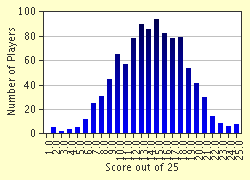Quiz Answer Key and Fun Facts
1. The term 'robber baron' refers to:
2. A leader of the Nationalist movement in the U.S. in the 1780s was:
3. The overall strategic policy of the Union to destroy the Confederacy through a combination of constant pressure and slowly wearing down the South's ability to wage war was called:
4. The growth of most American cities from 1880 onwards was determined primarily by:
5. What event made Kennedy a national hero in 1962 due to the way in which people believed he successfully stood up to the Russians?
6. The Spanish-American War resulted in which of the following territories being ceded by Spain to the United States?
7. This battle is widely regarded as the key turning point of World War II in Europe. Which is it?
8. Benjamin Franklin was an American whose life exemplified which of the following movements?
9. The French Colonies in Canada during the 17th and 18th centuries developed an economy dependent primarily on:
10. President Carter's administration had its greatest difficulties with its:
11. William Howard Taft's approach to American Imperialism was known as:
12. The use of alternating current to allow transmission of electric power over long distances was perfected by:
13. After the assassination of JFK, the popular press's nickname for the White House during the Kennedy administration was:
14. What incident led to Lyndon Johnson's escalating American involvement in Vietnam by sending more than 550,000 soldiers to actively fight in the Viet Cong and the North Vietnamese?
15. In 1830, about what proportion of white Southern families owned slaves?
16. Harding's administration, in particular, was known for its:
17. In 1948, what city did the U.S., Britain, and France have to keep supplied for over 300 days in a massive airlift due to the Soviets cutting off land based supply routes in an effort to drive the Westerners out of the city?
18. Today, an average of one in five Americans moves to a new residence each year. In American cities of 1900, that figure was closer to:
19. The conquistador responsible for the conquest of Montezuma and the Aztec empire in Mexico was:
20. At turn of the century (c. 1900) American artists of the realist school tended to make ______ the subject of most of their paintings.
21. The Coercive Acts were passed in reaction to:
22. Where did MacArthur land his forces behind North Korean lines in an effort to trap the North Korean Army and quickly win the Korean War?
23. Jane Addams was a turn of the century activist most well known for her work in:
24. Which country did the U.S. have to 'protect' Panama from after Panamanian revolutionaries successfully overthrew their rulers and announced their independence?
25. In the 1830s, states' rights and the concept of nullification were championed most notably by:
Source: Author
bailamos
This quiz was reviewed by FunTrivia editor
bloomsby before going online.
Any errors found in FunTrivia content are routinely corrected through our feedback system.


